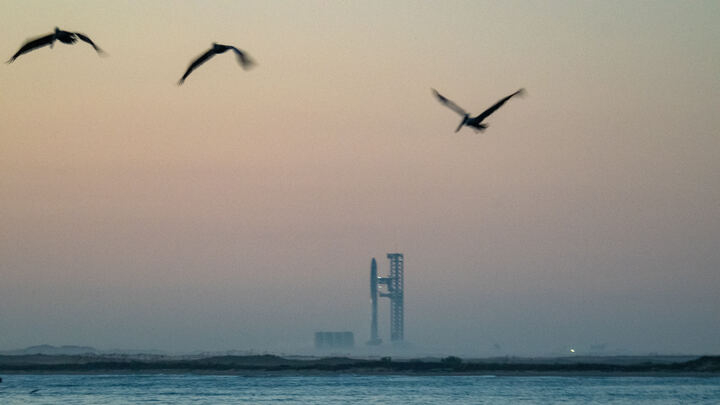Conservationists raise alarm over Air Force plan to land SpaceX Starships on bird sanctuary atoll
“Installing rocket landing pads on Johnston Atoll cannot occur without significantly disrupting wildlife..."

The U.S. military is considering Johnston Atoll, a remote Pacific island chain that serves as an important refuge for dozens of seabird species, for "two commercial rocket landing pads" to test giant cargo rocket landings for the Department of the Air Force's (DAF) Rocket Cargo Vanguard program, and it's getting push-back from environmentalists.
The Rocket Cargo Vanguard program aims to develop the technologies required to rapidly deliver up to 100 tons of cargo anywhere on Earth using commercial rockets. Though not explicitly named, Elon Musk's SpaceX is currently the only company —commercial or otherwise — capable of manufacturing rockets designed for landing and reuse, and its Starship megarocket is DAF's leading contender. The Air Force outlined its plans in a Federal Registry notice last month. Objections from the American Bird Conservancy (ABC), however, may hinder plans for the new landing pads on the South Pacific atoll.
Johnston Atoll lies about 825 miles (1,325 kilometers) southwest of Hawaii, and is home to several different species of seabirds, including the largest known colony of Red-tailed Tropicbirds. It was designated a refuge for native bird populations in 1926, but suffered environmental degradation through 2004, due to its use by the U.S. military as a nuclear weapons testing and chemical weapons disposal site. Since the military's departure from the islands, restoration efforts have helped raise Johnston Atoll's bird population back to nearly 1.5 million. Now, critics say the planned new rocket infrastructure could undo decades of conservation work.
“Installing rocket landing pads on Johnston Atoll cannot occur without significantly disrupting wildlife," said ABC president Michael Parr in a statement. DAF has stated that environmental reviews will be conducted before any operations move forward, but ABC say it's not enough.
ABC says the islands have become a crucial nesting habitat since the military's 2004 departure. Seabirds fly for thousands of miles across open water to reach Johnston Atoll, which sits alone amidst more than 570,000 square miles of ocean. Often times, the ABC says, it is the only land these birds see in their entire lives.
"The proposed 10 rocket landings per year would pose serious ecological risks, including hazardous debris, contamination, noise pollution, and other impacts from potential failures and explosions," it says in the ABC statement, adding, "opening Johnston's airstrip to planes would destroy the ground-nesting seabird colonies that have reclaimed the entire runway."
ABC expects the DAF to issue a Draft Finding of No Significant Impact (FONSI) in the near future, but believes the study will overlook the possible major impacts to the region's bird populations. Instead, they are requesting the DAF prepare a full Environmental Impact Statement "to better assess the potential hazards posed by the project."
Get the Space.com Newsletter
Breaking space news, the latest updates on rocket launches, skywatching events and more!
Starship is SpaceX's newest rocket under development, and currently stands as the world's largest, most powerful launch vehicle. The company began orbital flight tests of the megarocket in April 2023, with a mostly steady progression of milestones over the course of eight launches. It's last two though, which launched a taller, upgraded version of Starship's upper stage, have stinted that progress, with both flights ending in the unexpected loss of the vehicle during ascent.
SpaceX has already faced environmental scrutiny over its Starbase test site near Boca Chica Beach in South Texas, where it manufactures and launches Starship from a facility surrounded by other dedicated wildlife areas. Past launches have sparked legal action and criticisms from environmentalists there as well.
SpaceX has designed Starship to be fully reusable, and capable of carrying both crew and cargo to Earth orbit, the moon, and eventually Mars. It's built for high-capacity, rapid-turnaround spaceflight, and is central to SpaceX’s long-term vision to make human life interplanetary. Beyond commercial and military applications, NASA has contracted a version of Starship under its Human Landing System (HLS) program to serve as one of the lunar landers for the agency's Artemis Program, which aims to return astronauts to the moon’s surface later this decade. It is slated to land the first Artemis astronauts on the moon on the Artemis 3 mission no earlier than 2027.
Join our Space Forums to keep talking space on the latest missions, night sky and more! And if you have a news tip, correction or comment, let us know at: community@space.com.

Josh Dinner is the Staff Writer for Spaceflight at Space.com. He is a writer and photographer with a passion for science and space exploration, and has been working the space beat since 2016. Josh has covered the evolution of NASA's commercial spaceflight partnerships and crewed missions from the Space Coast, as well as NASA science missions and more. He also enjoys building 1:144-scale model rockets and human-flown spacecraft. Find some of Josh's launch photography on Instagram and his website, and follow him on X, where he mostly posts in haiku.
You must confirm your public display name before commenting
Please logout and then login again, you will then be prompted to enter your display name.
